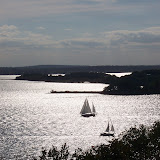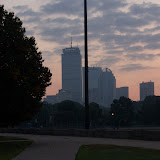
I spent part of this weekend reading
God's Harvard: A Christian College on a Mission to Save America, by Hanna Rosin. The book centers on Patrick Henry College, founded in 2000 by Michael Ferris, the fundi-gelical conservative Christian activist best known for his work leading the Homeschool Legal Defense Association. (Like it or not, he's one of the reasons people like me got to have the childhood we got to have . . . even if our home education didn't have quite the results Ferris is looking for!)
 God's Harvard
God's Harvard tells a story that is the natural extension of the 2005 documentary
Jesus Camp, which explored Christian evangelical culture as experienced by children ages 7-13. We've leapt over the mid-teen years, and are now introduced to an academically elite group of Christian homeschoolers ready to enter college. You can check out an early draft of a chapter from
God's Harvard,
"God and Country", which was published by Hanna Rosin in the
New Yorker (27 June 2005).
As usual, it is extremely irritating to have "homeschooling" become conflated with
conservative Christian homeschooling with barely an acknowledgment.
John Holt (whose papers have just been donated to the Boston Public Library!!) and the
free school movement are mentioned only in passing, rolled into the early history of "the movement" in such a way that it's never clear there are other ways families choose to home educate besides plunking kids down in front of intelligent design videos, drilling them in the tenets of Christian nationalism, and preaching the evils of toxic popular culture, all the while enforcing dress codes and "courtship" standards.
At the same time, I always find an outsider's perspective on homeschooler cultures fascinating; Rosin's narrative is an ever-shifting mosaic of the familiar and the alien. Whether secular or sectarian, home-educated kids tend to have close relationships with their siblings and parents, be skeptical of mainstream culture and education, and enter their young adulthood with a disconcerting mix of maturity and naivete.
"Homeschooling families," Rosin writes, "tend to judge each other by their views on structure and authority; the Patrick Henry families tend to fall on the strict end of that scale. Homeschool families have no school communities or obvious support system, so they tend to group around gurus or schools of thought" (90). The problem is, the only examples she gives are of the Patrick Henry variety, not the hippie home-educator "free schools, free people" types. Proof, I suppose, of our dwindling numbers. Rosin reports, with numbers similar to those in
Jesus Camp, that of the estimated 1-1.5 million home educators (unclear whether she's talking families or young people), a whopping 80% identify themselves as "evangelical Christian" (62).
Clearly, we home-educated feminists are outnumbered by the evangelicals; I guess we'll just have to raise a little more hell!
Further Reading about the Religious RightHere are a few other fascinating books on the subject of conservative Christian counterculture from the last few years.1.
Kingdom Coming: The Rise of Christian Nationalism, by Michelle Goldberg provides a good introduction to the political dimensions of the current conservative Christian counterculture.
2.
American Facists: The Christian Right and the War on America, by Chris Hedges provides less journalism and more philosophy than Goldberg, suggesting parallels between current Christian political thought and twentieth-century European fascism.
3.
Monkey Girl: Evolution, Education, Religion, and the Battle for America's Soul, by Edward Humes and
4. The
Kitzmiller v. Dover decision, which is brilliantly and lucidly written by Judge Jones, both document the recent ruling against the teaching of intelligent design in Dover, Pennsylvania schools.
5.
God On Trial: Dispatches from America's Religious Battlefields, by Peter Irons (I haven't read this one yet, but it looks good!) provides historical-legal context for the current struggle over the relationship between religion and government.
6. Jon Krakauer's
Under the Banner of Heaven: A Story of Violent Faith goes beyond its story of Mormon fundamentalism to explore the thin line between faith and madness.
7.
The Battle for God, by historian of religion Karen Armstrong, is a dense personal favorite, charting the rise of religious fundamentalism as a response to the modern era.
*Images from www.powells.com and www.amazon.com
Spending: A Utopian Divertimento, by Mary Gordon. I've actually already started this novel, which is about a woman artist and her self-appointed muse, about art and work, relationships and sex, money and ethics, feminism, and a whole lot more.
Dragonhaven, by Robin McKinley. I've been saving this one for a couple of months. It's always a treat when one of your favorite authors comes out with something new.










































